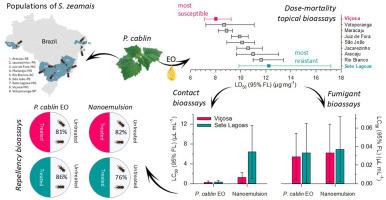广藿香精油和纳米乳对玉米象的杀虫效果及特性研究
IF 2.5
2区 农林科学
Q1 AGRONOMY
引用次数: 0
摘要
害虫对世界各地的储粮构成了重大风险,尽管合成农药有效,但它们在环境和健康方面存在缺陷。植物精油(EO)具有杀虫特性,是一种很有前途的替代品。本研究评价了广藿香精油及其纳米乳对9个储粮害虫玉米象的毒力。共鉴定出15种化合物,其中以广藿香醇为主要化合物(55.04%)。通过局部暴露、接触暴露和熏蒸暴露对EO进行了测试。驱避效果和种群增长效果也进行了评价。EO的杀虫速度快,平均中位致死时间(LT50)为53 h。所有种群均表现出相似的反应,其中viosa种群最敏感,而Sete Lagoas种群最耐受性。造成50%死亡率所需的EO和纳米乳浓度分别为0.30 ~ 6.37 μL mL−1(接触)和0.029 ~ 0.037 μL mL−1(熏蒸)。在所有暴露时间内,EO及其纳米乳均能有效驱避水蚤种群,LC50和LC70水平均为有效驱避剂。除了4、6和8 h的LC50和24 h后的LC70外,两种种群的驱避效果均不显著。纳米乳剂浓度的增加降低了两种种群的繁殖指数(ri)和食用量。种群下降(ri < 0)从50.15 μL kg−1 (viosa)和67.29 μL kg−1 (Sete Lagoas)开始。这些结果突出了玉米玉米瘟菌在储粮中管理玉米玉米瘟菌的潜力。本文章由计算机程序翻译,如有差异,请以英文原文为准。

Characterization and insecticidal effects of the essential oil and nanoemulsion of Pogostemon cablin on populations of Sitophilus zeamais
Insect pests pose significant risks to stored grains worldwide, and while synthetic pesticides are effective, they have environmental and health drawbacks. Plant essential oils (EO), with insecticidal properties, offer a promising alternative. This study evaluated the toxicity of Pogostemon cablin (patchouli) EO and its nanoemulsion on nine populations of Sitophilus zeamais, a major pest of stored grain. Fifteen compounds were identified in the EO, of which patchoulol was the major compound (55.04 %). The EO was tested through topical, contact, and fumigation exposures. Repellency and population growth effects were also assessed. The EO demonstrated fast insecticidal action, with an average median lethal time (LT50) of 53 h. All populations showed similar responses, with the Viçosa population being the most susceptible, and Sete Lagoas the most tolerant. EO and nanoemulsion concentrations required to cause 50 % mortality ranged from 0.30 to 6.37 μL mL−1 (contact) and 0.029–0.037 μL mL−1 (fumigation). The EO and its nanoemulsion were effective repellents against the Viçosa population at LC50 and LC70 levels across all exposure times. For the Sete Lagoas population, repellency was also observed, except for LC50 at 4, 6, and 8 h, and LC70 after 24 h. Increasing nanoemulsion concentrations reduced reproductive index (ri) and grain consumption in both populations. Population decline (ri < 0) began at 50.15 μL kg−1 (Viçosa) and 67.29 μL kg−1 (Sete Lagoas). These results highlight the potential of P. cablin EO for managing S. zeamais in stored grain.
求助全文
通过发布文献求助,成功后即可免费获取论文全文。
去求助
来源期刊

Crop Protection
农林科学-农艺学
CiteScore
6.10
自引率
3.60%
发文量
200
审稿时长
29 days
期刊介绍:
The Editors of Crop Protection especially welcome papers describing an interdisciplinary approach showing how different control strategies can be integrated into practical pest management programs, covering high and low input agricultural systems worldwide. Crop Protection particularly emphasizes the practical aspects of control in the field and for protected crops, and includes work which may lead in the near future to more effective control. The journal does not duplicate the many existing excellent biological science journals, which deal mainly with the more fundamental aspects of plant pathology, applied zoology and weed science. Crop Protection covers all practical aspects of pest, disease and weed control, including the following topics:
-Abiotic damage-
Agronomic control methods-
Assessment of pest and disease damage-
Molecular methods for the detection and assessment of pests and diseases-
Biological control-
Biorational pesticides-
Control of animal pests of world crops-
Control of diseases of crop plants caused by microorganisms-
Control of weeds and integrated management-
Economic considerations-
Effects of plant growth regulators-
Environmental benefits of reduced pesticide use-
Environmental effects of pesticides-
Epidemiology of pests and diseases in relation to control-
GM Crops, and genetic engineering applications-
Importance and control of postharvest crop losses-
Integrated control-
Interrelationships and compatibility among different control strategies-
Invasive species as they relate to implications for crop protection-
Pesticide application methods-
Pest management-
Phytobiomes for pest and disease control-
Resistance management-
Sampling and monitoring schemes for diseases, nematodes, pests and weeds.
 求助内容:
求助内容: 应助结果提醒方式:
应助结果提醒方式:


